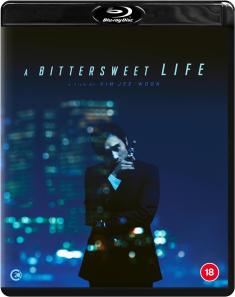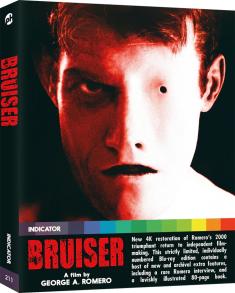LG 2019 Z9 Signature 8K OLED TV (88Z9PUA)
Overview -Overview -- Serving as LG's first 8K OLED TV and the company's biggest OLED TV model currently available, the 88-inch Z9 is an absolutely stunning display through and through. With its giant-sized self-emissive panel, the TV combines OLED pixel-level contrast with a near projector-like sense of immersion. But while the overall picture quality here is nearly unmatched, the actual benefits of 8K resolution remain rather subtle. Likewise, there are some minor uniformity issues and the price is prohibitively high for most consumers. Of course, at about $30,000, this isn't a model being geared toward the average buyer. This is clearly a premium product designed for the premium market -- and in that regard, it lives up to its promise. As far as I'm concerned, if you have the cash, the Z9 just might be the best way to experience big-screen HDR content in a home theater. Recommended.
Intro
While I would have liked nothing more than to receive a Z9 loaner for a prolonged review, shipping an 88-inch $30,000 TV to multiple publications just isn't a feasible endeavor for any company. With that in mind, LG was kind enough to bring me out to its Silicon Valley Lab for a full day of testing with the Z9 instead.
As part of my evaluation, I was given one-on-one time with the display along with access to pattern generators and calibration equipment that LG provided. And in the interest of full disclosure, though I spent the majority of my evaluation solo, I did ask LG's team to step in to assist me with setting up some of the meters and software to take some basic measurements during my testing, as well as to set up a computer system for an 8K HDR playback demo.
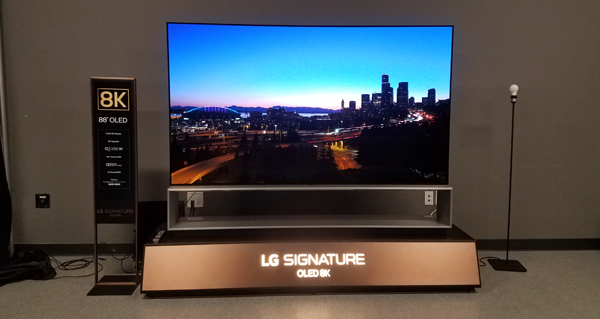
(Note: The Z9's included TV stand is placed on an additional, separate display base in the above photo)
Offering a jump in resolution and size over the company's other OLED TV options, the uber-premium 8K Z9 is LG's most expensive and most impressive 2019 display. Carrying over many of the same features found on its flagship 4K sets, the TV offers HDMI 2.1 connections, support for a full suite of HDR formats (with the exception of HDR10+), ThinQ and webOS smart TV capabilities, and Dolby Atmos support with an integrated sound system.
Likewise, the display uses an 8K version of LG's Alpha 9 Gen 2 Processor, which offers similar AI upscaling capabilities as those found on the C9, E9, and W9 4K TVs, while expanding the 4-step noise reduction used on those models to a more robust 6-step process to better suit the increase in resolution.
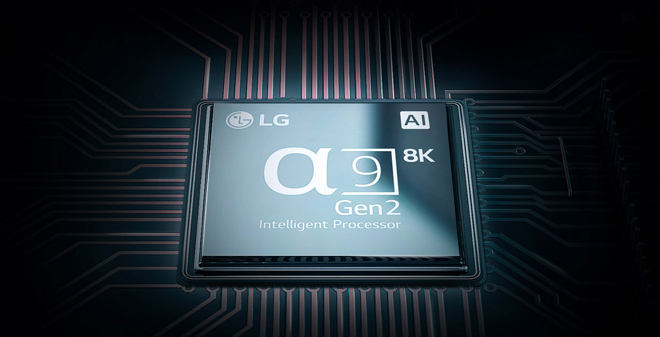
And helping to differentiate the TV from some competitors' 8K offerings, LG's 8K OLED has been engineered to produce high Contrast Modulation. In very simplified terms, this measurement essentially calculates how easy it is to actually distinguish between different pixels (for a more technical description CLICK HERE). According to LG, many competing 8K sets have lower Contrast Modulation as a result of methods used to enhance viewing angles on VA LCD panels -- something that isn’t an issue for LG's OLED and IPS TVs.
To demonstrate this point, the company showed a couple side-by-side demos with a Samsung 8K TV, using specific images and test patterns to reveal how the Samsung was prone to a mosquito net effect when viewing images up close. And while the demo did indeed reveal clearer pixels on the LG TV, I'm not sure how visible those differences would be during real world content.
The Z9 is currently available in an 88-inch screen size for $29,999.99. With that said, it's possible the company might expand its 8K OLED offerings with more sizes in the future.
Specs
The 88-inch Z9 features an 8K OLED panel with a resolution of 7,680 x 4,320 and a 16:9 aspect ratio. In addition, the display includes support for Dolby Vision, HDR10, HLG, Technicolor Advanced, and close to 100% coverage of the DCI-P3 wide color gamut. And while the unit does not include HDR10+ support, LG says its own HDR Dynamic Tone Mapping Pro option is capable of producing similar results with HDR10 content.
Offering an appropriately premium exterior to match its premium picture specs, the TV offers a virtually bezel-free construction with extremely thin black borders around the screen. And though not as strikingly slim as some of its 4K OLED counterparts, the panel still offers a relatively thin profile. With that said, the lower back portion of the screen does protrude out more to accommodate the set's inputs and processing components.
Forgoing a traditional pedestal stand or left and right feet, the display actually ships with a dedicated full-size TV stand of its own that it's designed to directly pair with. The stand itself also houses some of the display's components and audio elements, which means that the two pieces have to be connected via an included proprietary cable in order for the TV to operate. The handsome silver stand also features lower shelf space to house a media player or other devices. With that said, there isn't enough space in front of the display to rest a separate sound bar, and because the stand and display need to be connected in order for the TV to work, the Z9 can't be wall mounted. With the stand attached, the whole system measures 77.2" x 57.3" x 11".
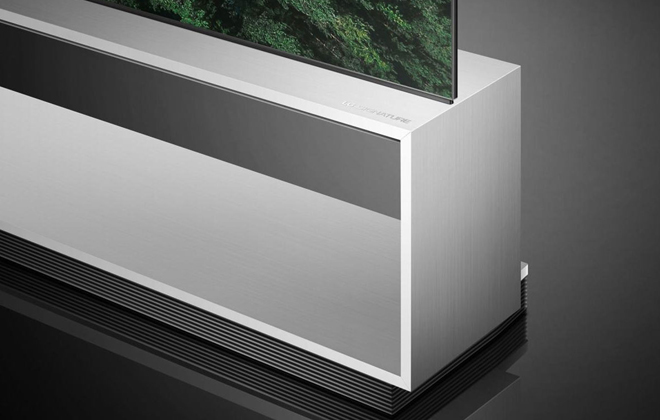
The back left of the panel house the TV's various connections, including four HDMI 2.1 inputs (one ARC/eARC), offering support for high frame rate (HFR) 120 fps playback, enhanced audio return channel (eARC), and gaming features like variable refresh rate (VRR) and an automatic low latency mode (ALLM) when connected to a compatible device. With that said, select HDMI 2.1 features will require a future firmware update to operate.
Outside of HDMI, the TV also includes three USB Ports 2.0 ports, an RF Connection, one Composite input, an Ethernet port, an RS-232C input, and a Digital Audio Output connection. In addition, Wi-Fi 802.11ac and Bluetooth 5.0 connectivity are implemented as well. And rounding out the package, is a more premium version of LG's Magic Remote with a silver metal construction rather than the black plastic build used with the C9.
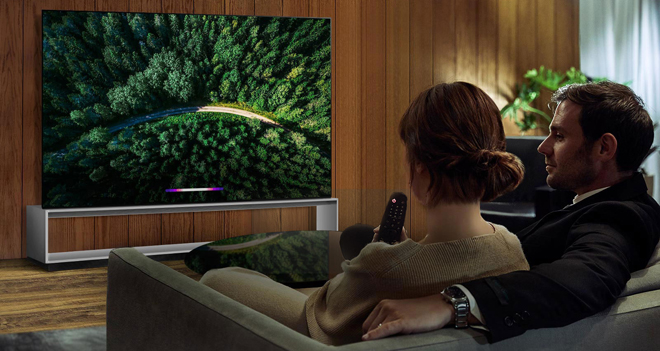
Under the hood, the display is powered by LG's Alpha 9 Gen 2 8K Processor with deep learning algorithm and ThinQ AI technology, allowing the TV to optimize picture and sound quality based on the source content being played, along with the ability to adjust its tone mapping curve and screen brightness to better match ambient lighting conditions in a user's room. Likewise, the TV supports voice control via the remote or separate Google Assistant and Alexa devices.
Finally, the Z9 also includes Dolby Atmos support and the ability to up-mix two-channel audio to virtual surround sound via the TV's surprisingly robust integrated 4.2 Channel 80W (40W Woofer) speaker system.
4K HDR Performance
To test out the Z9's 4K HDR picture performance, I sampled a variety of 4K Ultra HD Blu-ray discs via an Oppo UDP-203, and various streaming titles from Netflix and YouTube. Likewise, I was able to gather some basic brightness and color measurements using a Colorimetry Research CR-100 meter and CalMAN software that LG was kind enough to provide during the demo.
For the most accurate out-of-box HDR10 and Dolby Vision settings, users should toggle on the Cinema picture mode with Peak Brightness set to High and all other processing settings deactivated. Using this mode without extra calibration, the Z9 is capable of achieving a peak brightness of about 770 nits on smaller test patterns and about 97% coverage of the P3 color gamut. Like all OLED displays, however, peak brightness is more limited on larger test patterns. Here's a full rundown of the brightness measurements using a 1% to 100% window:
- 1% window - 770 nits
- 5% window - 770 nits
- 10% window – 746 nits
- 25% window – 419 nits
- 50 % window – 255 nits
- 100% window – 140 nits
But while peak and full-screen brightness capabilities are not as high as flagship LCD models, the panel's pixel-level contrast is still able to produce stunning images, resulting in overall HDR performance that bests any LCD I've tested.
Due to the self-emissive nature of the OLED panel, the TV does not need a backlight. Instead each of the screen's more than 33 million pixels is capable of producing its own light, allowing the display to darken and brighten with pixel-level precision rather than have to rely on a couple of hundred local dimming zones. This results in perfect black levels and precise specular highlights without blooming. With that said, the TV is still susceptible to some fluctuations in brightness due to ABL and ASBL. For more information on these functions and how they might affect picture on the Z9, check out the relevant section in our recent review of the LG C9 HERE.
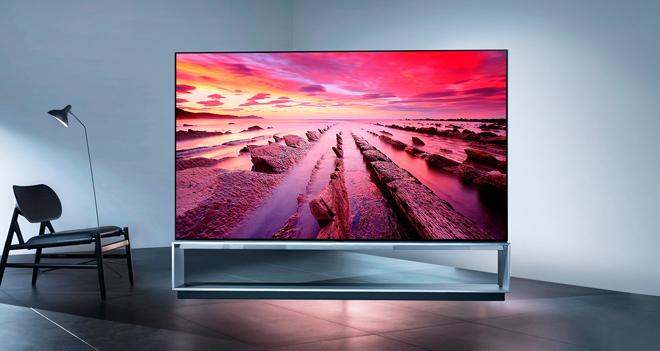
Sampling a variety of scenes from my usual assortment of HDR10 and Dolby Vision demo titles -- including Blade Runner, The Matrix, Ex Machina, Game of Thrones, Wonder Woman, Kong: Skull Island, Spears and Munsil's Calibration Disc, and a Dolby demo disc -- left me simply awed. Seriously, watching 4K HDR content upscaled to 8K on a massive 88-inch OLED screen lived up to the hype, resulting in a near projector-like sense of immersion while maintaining inky blacks and dazzling highlights.
Neon lights in Blade Runner radiated from the screen with sumptuous intensity and saturation, while green code scrolled across the panel with a cool electronic glow in The Matrix. The opening crypt sequence in episode 9 of Game of Thrones maintained perfect blacks and balanced shadow delineation as the characters' torches spread light throughout the room without a hint of blooming.
Dolby's Escape CG animated short film was also especially impressive, allowing the Z9 to render a gorgeous, colorful sci-fi world. Likewise, close-ups of animals on the Spears and Munsil demo disc showcased the panel's incredible upscaled 8K detail, with nary an imperfection in sight on the massive 88-inch panel -- even from an extremely close vantage point.
To put it simply, watching high-quality 4K HDR content on the 88-inch Z9 resulted in one of the most enveloping viewing experiences I've had outside of a theater. Getting to see Blade Runner, one of my favorite films, rendered through the display's dazzling HDR, black level, and color performance on a screen that size was simply a home-theater dream come true.
Though I still need to get more one-on-one time with MicroLED screens from Samsung and Sony, outside of that emerging tech, the Z9's giant OLED panel just might be the best way to currently watch HDR movies at home. Sure, projectors can get bigger, but consumer models lack the ability to render highlights and black levels the way the Z9 can.
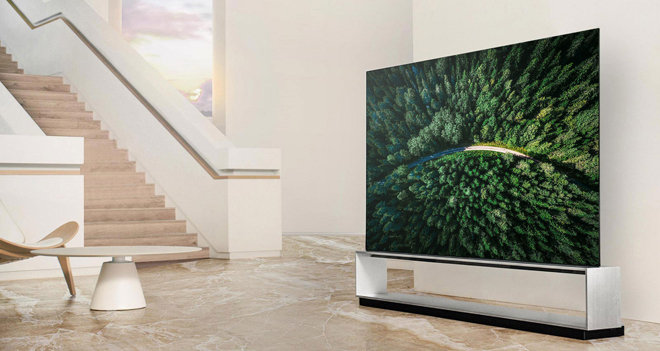
Of course, as amazing as the Z9 proved to be, no display is perfect -- even a $30,000 one.
Shadow delineation in a few dark scenes in The Matrix and episodes of Chilling Adventures of Sabrina looked a little crushed, hiding some details that have been visble on other LCDs I've tested. I also detected a hint of false-contouring here and there, particularly in the background of one scene in Ex Machina where harsh red lighting fills the room. Likewise, faint vertical banding lines were visible on dark grey test patterns. This is a common issue for OLED panels and wasn't really a concern during actual content.
A bit more irritating, however, was one faint vertical line that was occasionally visible right down the center of the screen during a few isolated scenes. I'm not sure if this line was related to the grey tone banding issue or something else entirely, but it was typically visible during sequences where different shades of one color filled most of the screen. For example, the line was visible during a scene in The Avengers where Iron Man is surrounded by murky water. I've encountered vertical bands or seams like this on other TVs from various manufacturers, and though somewhat common, it's still disappointing to see on a $30,000 set.
To be clear, however, I only noticed the line in a few instances, and this is more of a nit-picky observation than a major drawback. But when a display is performing at as high a caliber as the Z9, I do feel like nit-picky observations should be noted.
8K HDR Performance
Though 8K content is almost non-existent for the time being, LG did have a gorgeous reel of uncompressed 8K HDR material available for viewing via a rather elaborate computer rig hooked up to the Z9. The content was being played directly from DaVinci Resolve editing software and consisted of a lot of the same demo footage that is also featured in 4K HDR on Spears and Munsil's Ultra HD Blu-ray Calibration Disc.
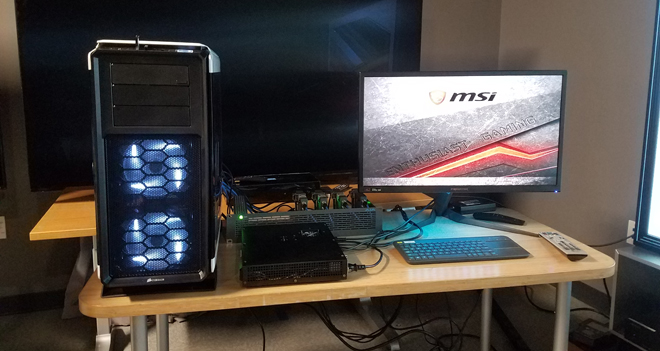
Since I actually had that disc with me, this presented me with the rare opportunity to switch between 4K HDR and 8K HDR feeds of the same content on an 8K TV -- allowing me to see if there were any discernable benefits from the jump to native 8K playback versus 4K content being upscaled to 8K.
The answer? A little… but only in select scenes from a very close viewing distance.
To be clear, the uncompressed 8K HDR footage looked simply incredible on the Z9 with absolutely exquisite clarity, spectacular colors, deep blacks, and impressive specular highlights without a loss of detail -- whether from a seated distance of about 7 feet or with my face smacked right up in front of the screen.
The only issue? Well, for the most part, the 4K HDR footage on the same TV looked just as spectacular. Switching between the two sources while the material played or while pausing on certain shots to compare still images yielded incredibly similar results on screen, making it very hard to see a difference.
Definition on intricate details on bird feathers and reptile scales during gorgeous close-up shots of animals looked ever-so slightly more refined when standing up close to the screen on the 8K feed, but from a normal viewing distance I'm honestly not sure I'd be able to discern between the two sources. One scene featuring a wide shot of pedestrians walking by hot springs and geysers may have offered the most visible upgrade, making it a little easier to make out each individual person in the distance on the 8K footage -- but, again, the difference was very subtle.
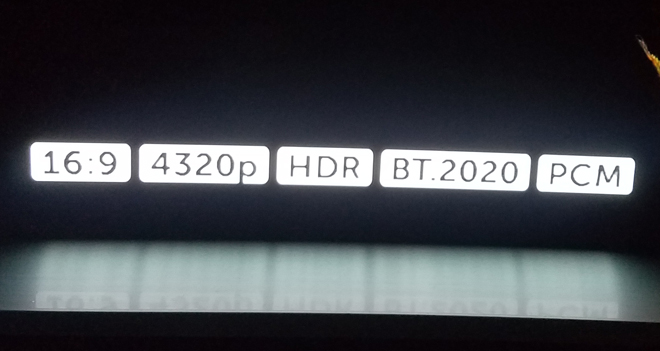
Of course, this is only one comparison and other 8K footage might present more visible differences. There was also a delay of a couple seconds when switching between the 4K and 8K sources, so an actual side-by-side comparison would offer a more accurate test. Likewise, the 4K content was of course being upscaled to 8K so a head-to-head with a similarly sized 4K OLED would be the best way to see the full benefit of all the Z9's extra pixels.
Still, the fact that differences were hard to spot using this method only goes to further reinforce just how subtle the upgrade from 4K to 8K can be to the human eye.
8K AI Upscaling
Outside of native 4K and 8K content, I also sampled the display's advanced AI deep learning 8K upscaling feature using some standard Blu-rays and even a DVD.
The AI feature essentially intelligently employs the TV's various noise reduction, sharpening, and color adjustments by analyzing the specific content being played in reference to a large database of material. In theory, this should result in lower quality material looking better on the 8K panel.
High quality 1080p Blu-rays didn't really seem to benefit much, if at all, from the feature being toggled on. That's not to say that SDR Blu-rays didn't look great, though. They absolutely did. I simply mean that the TV's standard upscaling without the AI feature already does an incredible job, so further AI based noise reduction and processing just isn't necessary.
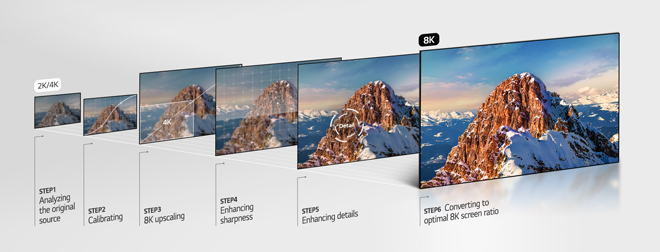
With DVDs, however, I did detect some benefits. First things first, I was actually quite impressed by just how well the TV scaled my standard-def DVD copy of The Avengers using the default ISF Expert Dark Room settings. Sure, the disc clearly looked lower quality than HD, but considering the amount of scaling involved, the image was pretty solid. Toggling on the AI picture setting produced a slight but still appreciable improvement in definition and picture stability, helping to smooth out some of the compression artifacts and sharpen fine detail without any egregious blurring or smearing of the image. Likewise, colors looked a hair bolder too.
For users who want the most accurate picture, settings like this should probably still be avoided and the subtle differences were never as dramatic as buzzwords like "deep learning" might imply. Still, based on my experience, the AI tech on the Z9 can help to enhance lower quality material and streams a bit.
Final Thoughts
Based on a full day's worth of testing and demoing different content, the 88-inch LG Z9 8K OLED just might offer the best way to experience big-screen HDR content in the home right now. With that said, the actual benefits of the jump to 8K resolution remain subtle. At the end of the day, the Z9 more or less performs like a super-sized version of the company's 4K OLED offerings -- bringing the benefits of OLED tech's perfect blacks and self-emissive contrast to a screen so big it comes close to offering a projector-like sense of immersion with so many pixels you can get as close as you want.
And well, that's pretty awesome.
While I'm still not entirely sold on the need for 8K resolution itself, there is no denying just how gorgeous the resulting performance is. There are some minor quirks and panel uniformity issues but, as a whole, the Z9 earns its premium status. There are other impressive large-screen 8K TVs from Sony and Samsung on the market, and while those models can get much brighter, it's hard to beat the precision contrast benefits of the Z9's OLED panel.
Those looking for a better price to performance value will be better off sacrificing 11-inches for the much more affordable 77-inch C9 4K OLED TV ($5,497). But if cost is not a concern and you want the biggest and best OLED you can buy right now, then the Z9 is Recommended.






